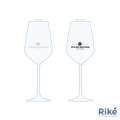How does glass engraving work?
.jpeg)
What is engraving? A question we often hear. Understandable! Engraving is the permanent application of a text, logo or pattern on an object (such as glass), by removing material. You remove a piece of the glass, leaving the logo behind. Engraving is a sustainable choice: because an engraving is permanently applied, the logo cannot disappear. How does it work and what does it look like on glassware? Read the answers to the questions in the blog!
What engraving techniques are there?
There are a number of commonly used engraving techniques. We list the three most commonly used engraving techniques: laser engraving (co2 laser engraving and UV laser engraving), sandblasting and hand engraving.
-
Laser engraving
Laser engraving uses a powerful laser beam to etch a design into the glass. The heat from the laser causes the surface of the glass to melt slightly, leaving a matt, white engraving. This process is very precise and ideal for applying detailed logos, text or patterns.
With laser engraving, glasses are made in advance for the machine to produce quickly and a lot at a time.
There are two common laser engraving techniques for glassware:
- CO₂ laser engraving: This method uses a CO₂ laser beam to mark the glass surface. The result is a matt, white engraving with a fine finish. CO₂ laser engraving is often used for glassware because of its speed and precision.
- UV laser engraving: This technique uses a UV laser with a shorter wavelength. This allows engraving with even more detail and without thermal damage to the glass. UV laser engraving is ideal for very fine logos and thin lines, such as on premium glassware or small surfaces. UV laser engraving takes a little longer on average than CO₂ laser engraving and is therefore slightly.
-
Sandblasting
Sandblasting is a method in which fine grains (usually sand) are blown against the glass at high pressure. This creates a deeper and even matte engraving. Sandblasting provides a high-quality finish and a luxurious look. It is not only particularly suitable for glassware, but also for mugs, where a deeper engraving is desired. Read more about that in the blog on mug engraving.
-
Hand engraving
Hand engraving is an artisanal technique where an engraving needle or grinder is used to etch a design into the glass by hand. This process is time-consuming and requires considerable skill, but produces unique, personalised results. Hand engraving is often used on exclusive glassware sets or gifts.
Which technique is most commonly used?
Laser engraving is most often used when engraving glassware. This is the most reliable engraving technique, as it is performed by a machine, thus eliminating human error. Sandblasting is mainly done on mugs. Hand engraving is something traditional. Fun to do once in a while! However, we do not do this on our products, as it is too time-consuming.
The history of engraving
Antiquity
Engraving has been around since prehistoric times. Stone-age people scratched figures and marks into rocks and bones with sharp stones, often as an art form or means of communication. In ancient Egypt and Mesopotamia, engraving was used to record texts and symbols in stone or clay tablets. Seals and cylinder seals played an important role in administrative and religious purposes.
Middle Ages
During the Middle Ages, engraving became increasingly sophisticated. Blacksmiths and goldsmiths engraved weapons, armour and jewellery, while monasteries made woodcuts for books and religious works. This period saw the first copper engravings, which later contributed to the development of intaglio techniques.
Renaissance
During the Renaissance, engraving became increasingly popular. Artists such as Albrecht Dürer perfected copper engravings and etchings, creating detailed prints. This technique became important for spreading art and knowledge in books and pamphlets. Utensils such as silver bowls and chalices were also delicately engraved during this period.
17th-19th century
In the 17th and 18th centuries, engraving was widely used on coins, stamps and luxury items. The Industrial Revolution in the 19th century brought mechanical engraving techniques, making mass production possible. This led to the emergence of engraved printing plates for banknotes and stamps.
20th century
With the advent of electric engraving machines and chemical etching in the 20th century, engraving became more precise. A major breakthrough was the invention of laser engraving, which enabled precise designs on glass, metal and plastic.
Why choose engraved glassware?
Engraved glassware is a stylish and smart choice for businesses, catering establishments and as personal or business gifts. It not only offers a luxurious look, but also has several advantages. Whether you are looking for a unique corporate gift, to enhance your hospitality business or just want something special, engraving is a durable and elegant solution.
Personalisation
Engraving allows you to fully personalise glassware. This means you can have a logo, name, date or even a special message applied. This allows companies to draw extra attention to their brand, while hospitality businesses get a professional look with personalised glassware. For weddings, anniversaries and other special occasions, an engraved glass is also a lasting keepsake.
Durability
Unlike printing, which can wear or fade due to washing up or frequent use, engraving always remains visible. The engraving is etched into the glass, so it does not wear away. This makes engraved glassware a durable and low-maintenance choice, especially for catering establishments where glasses are used intensively on a daily basis.
Exclusive look
Engraved glassware exudes quality and class. It adds a subtle but stylish touch to any glass. This is ideal for luxury brands, restaurants and events that want to create a premium look. Subtle engraving makes the glass more exclusive and sophisticated than standard printed glassware.
Conclusion: with engraved glassware, you choose a stylish, durable and versatile solution. Whether it's for branding, a special gift or a luxury look for a catering establishment, engraving is a smart choice that will last and impress.
Who is engraving optimal for?
Engraved glassware is a stylish and versatile choice for a variety of occasions and sectors. From hospitality to corporate gifts, and from weddings to marketing campaigns, glass with a personalised engraving always adds a unique and exclusive touch. Here are some common applications.
Hospitality & restaurants: Hospitality businesses reinforce their brand with engraved glassware, such as wine glasses, beer glasses or cocktail glasses with a subtle logo. This creates a luxurious and recognisable look.
Business relations & gifts: an engraved wine or whisky glass with company logo is a valuable gift. Ideal for anniversaries, end-of-year gifts and corporate gifts, with lasting impact.
Weddings & events: At weddings and anniversaries, personalised glasses, such as champagne flutes with names and date, provide a stylish touch and lasting memory.
Promotional campaigns: engraved glassware, such as candy jars, drinking glasses or decanters, is an original giveaway for trade fairs and events. Durable and timeless, ideal for long-term brand visibility.
Engraved glassware combines functionality with exclusivity, making it a popular choice for both business and personal applications.
Engraving or printing: which to choose?
When personalising glassware and tableware, you can choose between engraving and printing. Both techniques offer unique advantages and are suitable for different applications. But which option best suits your needs?
The difference between engraving and printing
Engraving is a technique in which a design or text is cut into the glass with a laser or mechanical tool. This creates a subtle, permanent mark without colour. Read more about it in the blog on the difference between engraving and printing.
Glass printing, on the other hand, uses special ink or ceramic paint that is applied to the glass and often burned in. This allows colours and detailed designs to be used.
When do you choose engraving?
Engraving is ideal when you want a timeless, chic look. It is perfect for exclusive corporate gifts, awards or glassware in high-end catering establishments. As the engraving is hard-wearing and does not fade, it is also suitable for everyday use.
When do you opt for printing?
Do you want an eye-catching logo or colourful design on your glassware? Then printing is the best choice. This is ideal for promotional material, events and hospitality where branding is important. Printing offers many creative possibilities and can even be dishwasher-safe, depending on the technique used.
Advantages and disadvantages of both methods
Engraving:
✔ Durable and hard-wearing
✔ Elegant, professional look
✔ Suitable for luxury products
❌ No colour options
Printing:
✔ Possibility of colour and detail
✔ Ideal for branding and promotion
✔ Many styles and finishes possible
❌ Can wear off over time, depending on technique
Which technique you choose depends on the look and purpose of your glassware. For subtle luxury, engraving is ideal, while printing ensures an eye-catching, colourful look!
So: what are you waiting for?
Engraved glassware is a smart choice for personalisation and branding. It is stylish, durable and suitable for businesses and individuals alike. An engraving does not wear off and remains visible for years, even after frequent use and washing up. This makes it ideal for catering establishments, corporate gifts and special occasions such as weddings or anniversaries.
In addition, engraved glassware exudes luxury and quality, creating a professional image. Whether you want to strengthen your brand or are looking for a unique gift, engraving offers a lasting impression.
Would you also like personalised glassware that stands out? Discover the possibilities and contact us!
Index
Popular blogs












